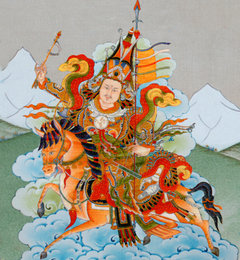I pondered this thought carefully and considered making it a poem, but I became concerned that the poetics might unintentional conceal what I wanted to say or that my poetic attempts would not be strong enough to carry the idea.
Teaching dressage well is a difficult thing to do. Not that this idea should surprise anyone, but to keep its simplicity and avoid losing the point in a sea of details is hard, especially when the central point is beyond what a verbal language can express with any clarity makes dressage instruction challenging.
The aids and the seat are usually taught mechanically and few people remain with an instructor or get instruction at a high enough level to overcome the issue created by this way of teaching. A few very upper-level teachers solve this issue by avoidance of detail until the student can find the flow and a few others only deal with the flow because they lack the detail. Anyway you look at it, confusion arises and needs to be clarified for wisdom to dawn.
When one reads out loud, punctuation informs the orator when to pause and when to take a breath. When on sings or chants a text, punctuation is ignored and the words are allowed to flow together like a river.
The actual process of riding and the use of the aids is to find the river and let it flow. In good dressage (whether under saddle or in hand), the aids harmonize with the flow. Energy moves in curved lines. A curved line contains an infinite number of straight lines and so the process of working the aids is a cadence of straight lines rarely lasting more than a few steps.
Straightening the horse or reaching the highest levels in the work is a shaping through these lines working with 7 to 8-degree shifts at times but in general 15-degree is the most common angle in play. This may be a bit esoteric, but these angles coupled with a few simple ratios form the precision of the aids which rarely seen or understood in the dressage of today.
Understanding these ratios and the play of angles is cadenced to produce all the movements in dressage and harmonise with the horse’s range of motion. Talented riders do this by feel and a well-educated rider combines awareness, thought and feel to achieve a high level of success with every horse.
Feeling one’s way through this is difficult and so good dressage is rare. The aids must flow with the river and not block or fight the current. First find the river and learn to flow. Working with the horse is not combat but a dance in the river.
Gentle and kind, we fly like a bird with our horses, using the air to support us. We surf the waves of the horse’s movement. This is the poetry that has no words but the direction in which to look. Feel the wind, ride the waves; it is what is warm and dry and what is moist and wet which fuels dressage. Warm and dry is upper-level work and the lower levels are about wet and moist.
Earth is the foundation and air supports the high levels. This was the old way of thinking about these things and so the old masters attempted to illumine the texture of the experience of dressage.
To my student who are in direct contact with me, this should make sense and to others, we can only hope. Good dressage is always possible, but it takes a trained mind to escape the obscurations. Practice and study is not enough.


Recent Comments